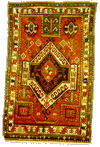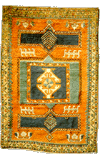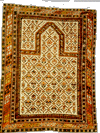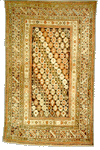

Caucasic area, between the Black Sea and the Caspian Sea, includes the
northern ciscaucasic steppe, Caucasus with its central chain of mountains,
and the southern transcaucasic zone, which borders with Armenian tableland.
 There
are no clear connection between Caucasic and Armenian carpet.
Both productions date to the XVI century. In most ancient products,
Anatolic influence first and then Persian one can be recognized; Anatol
and Persia bordered with Caucasic lands. The most ancient Caucasic
carpets might have been of nomad production and only later in time proper
centres of production have been established, among which the one in Kuba.
Someone (Schurmann)
There
are no clear connection between Caucasic and Armenian carpet.
Both productions date to the XVI century. In most ancient products,
Anatolic influence first and then Persian one can be recognized; Anatol
and Persia bordered with Caucasic lands. The most ancient Caucasic
carpets might have been of nomad production and only later in time proper
centres of production have been established, among which the one in Kuba.
Someone (Schurmann)  dates
Anatolic samples to the most ancient Caucasic production; among this samples
there is the already mentioned carpet with dragon and phoenix given by
Bode to the Berliner Museum. Decorations used by Caucasic tribes in the
Middle Ages are very closed to Anatolic ones, and so a common derivation
from Turkish tradition can be seen, which is connected with places of origin
such as Turkestan and Mongolia where among Chinese mythological figures
, the dragon and the phoenix can be found. Yet it is easier
to assume that Caucasic tribes were influenced by the near Anatolia, considering
the historical and geographical situation. Tribes living on Caucasic mountains
behaved differently from Armenians, they were directly connected with Persia
and culturally available to establish relationship with people beyond the
borders: it is yet necessary to consider Caucasic-Armenian carpet production
separately, even if some relationship with Anatolic and Persiann carpets
could represent a line of demarcation between the two productions.
dates
Anatolic samples to the most ancient Caucasic production; among this samples
there is the already mentioned carpet with dragon and phoenix given by
Bode to the Berliner Museum. Decorations used by Caucasic tribes in the
Middle Ages are very closed to Anatolic ones, and so a common derivation
from Turkish tradition can be seen, which is connected with places of origin
such as Turkestan and Mongolia where among Chinese mythological figures
, the dragon and the phoenix can be found. Yet it is easier
to assume that Caucasic tribes were influenced by the near Anatolia, considering
the historical and geographical situation. Tribes living on Caucasic mountains
behaved differently from Armenians, they were directly connected with Persia
and culturally available to establish relationship with people beyond the
borders: it is yet necessary to consider Caucasic-Armenian carpet production
separately, even if some relationship with Anatolic and Persiann carpets
could represent a line of demarcation between the two productions.
The disposition of Armenian people to establish relationships with
foreign countries, urged to exportation by commercial interests,  confirm
that (Caucasic) Armenian carpet preceeded Persian one. The
technique of knotting itself seems to confirm this.
confirm
that (Caucasic) Armenian carpet preceeded Persian one. The
technique of knotting itself seems to confirm this.
Characteristics of Caucasic-Armenian carpet
Some characteristics of Caucasic-Armenian production repeat in each examined samples. At first the figurations are more clearly delineated; naturalistic trend prevails which is particularly clear in carpets with animal content. Decorations of the rhomboidal ticking are aligned on rising lines in a mainly deep red coloured field; the figures of the dragon and of other animals can be easily seen. In the long run the whole decoration gets more and more schematic and flat. Forms become geometrical and abstract and the interpretation gets more difficult. Artistic severity is constant; even imported motifs are re-elaborated and expressed through severe but always original geometrism.
Carpets and dragon
Among the so called "dragon carpets", the most ancient one seems to be the famous carpet which has been bought in 1900 by Grafa Damasco and which arrived then at the Berliner Museum. Because of the Second World War, no more than few fragments remain of it. Another very important fragment kept in Bardini Museum in Florence could be dated to the same period (early XVI century) . Most ancient samples are characterized by a ticking motif which can be found in the decoration of Persian carpets and vases. In the field, which is usually red, the figuration of the dragon appears, often in double and particularly back against back.
 Sometimes,
other zoomorphic figures, such as the fighting phoenix, the lion and so
on, complete the decoration. On hemmings, arabesques and palmettes prevail.
All colours are quite vivid. Around the XVII century, figurations appear
less clear, they are more schematic and less delineated, with sober details
and vegetable decoration, which linked the drawings to the background with
its notched edges, flattens in long lengthwise strips. This flattening
course is more evident during the following century; the whole decoration
tends to abstraction while shades are duller.
Sometimes,
other zoomorphic figures, such as the fighting phoenix, the lion and so
on, complete the decoration. On hemmings, arabesques and palmettes prevail.
All colours are quite vivid. Around the XVII century, figurations appear
less clear, they are more schematic and less delineated, with sober details
and vegetable decoration, which linked the drawings to the background with
its notched edges, flattens in long lengthwise strips. This flattening
course is more evident during the following century; the whole decoration
tends to abstraction while shades are duller.
Floral carpets
Starting motif (dragons, phoenixes, fighting animals) gets richer by the introduction of wide vegetable motifs which are all extended upwards and disposed in different rows. Ticking construction gives the sensation of an endless drawing (typical characteristic of Anatolic carpet). Within the field, series of palmettes, big palms and ribbons of clouds are often included. As they are quite large, so to exclude their nomad origin, these carpets are supposed to have been manufactured in steady centres of production, probably in the centre of Kuba. Vegetable ticking carpets production covers a long period of time which goes from the XVI to the XVIII century. It undergoes the same transformation process already described for dragon carpets.
The common recall to Persian production, and particularly to the town
of Herat, is due to the frequent presence, on these floral samples, of
the so called "herati" field motif, where the two long lanceolate leaves,
which define a flower, are less definitely described. The group of reported
data seems to date the production between the XVII and the XVIII century.
During the last two centuries, decoration motifs described above (which
can be often found in Kurdish carpets) have just been repeated and have
lost originality. Different commercial requests lead production centres
of Kuba, Kasak, Karabagh, Daghestan, Derbent, Talish and others to increase
the number of drawings in such a way as to grant specific demands of the
market.
